Hey everyone, this AWEsome journey of AWE64 memory expansion boards isn’t over with the introduction of the MIDI FORGE Symphony – it was simply STARTING! And I can tell you, the MIDI FORGE Rhapsody won’t be the last chapter of this book! I’m really excited to share the latest addition to the AWE64 memory upgrade – the MIDI FORGE Rhapsody, a sleek, modernized 28MB memory expansion board for the Sound Blaster AWE64 Value and Gold models!
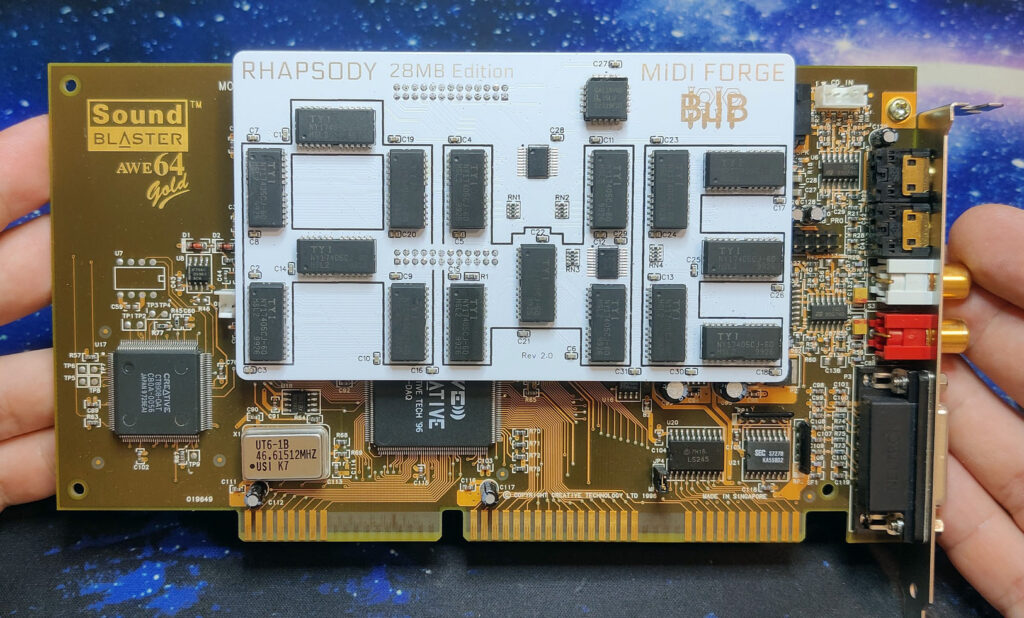
If you’ve been following my journey, you know I’ve been obsessed with maxing out these iconic 90s sound cards to unleash their full potential for retro gaming and MIDI music production. After countless hours decoding cryptic PALASM equations, wielding my thermal camera, and teaming up with my AI sidekick, I’ve created a board that’s not just a tribute to Creative Labs’ original design but a bold leap forward (if you ask me). This is how a memory expansion board should look like in my books! It has strong ties to the soundcard it attaches to. Let me walk you through why this project matters and what makes the Rhapsody so special.
Why did I design a second memory expansion board?
For those who love retro computing or MIDI wizardry, the AWE64 is a legend. Its EMU8K synthesizer and SoundFont tech brought games like Doom and Duke Nukem 3D to life with epic MIDI soundtracks, and it’s still a go-to for vintage music creation. But the catch? The Value’s measly 512KB and Gold’s 4MB of onboard RAM limit the size of SoundFonts you can load, holding back those lush, professional-grade sounds. Back in the day, Creative offered memory upgrades up to 28MB, but those modules are now rarer than an AWE64 Gold and cost a fortune. That’s where the MIDI FORGE Rhapsody comes in – a 28MB powerhouse that lets you load massive SoundFonts for crystal-clear MIDI, whether you’re composing symphonies or reliving Wing Commander III.
What sets the MIDI FORGE Rhapsody apart is its blend of nostalgia and innovation, designed to be the ultimate AWE64 upgrade. Unlike the bulky SIMMConn adapter, the Rhapsody is a compact, soldered PCB that’s a breeze to install and looks stunning in your retro rig.
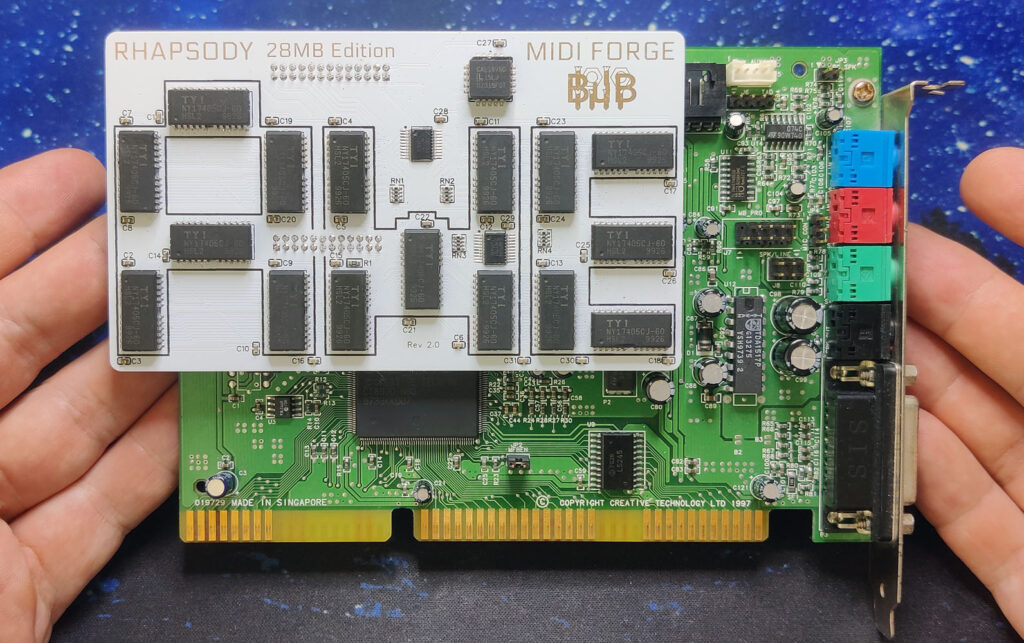

Here’s why it’s unique:
- Easier-to-Source Memory Chips: Forget scouring eBay for obscure DRAM. The Rhapsody uses 16 4Mx4, 5V DRAM chips commonly found in 72-pin EDO or Fast Page Mode SIMMs (60ns or faster). These are way more accessible, keeping costs down (about $10-15) and making builds easier for everyone.
- Sleek, Modern Design: With a matte black PCB and vibrant yellow silkscreen (or black on white), the Rhapsody fits snugly without hogging ISA slots. It’s assembled with precision using a stencil and hotplate for flawless solder joints, giving it a professional edge over clunky adapters. The fact that the memory chips are arranged in a way to spell the word “AWE” is just the icing on the cake!
- Universal Compatibility: This board works flawlessly on both AWE64 Value and Gold models right out of the box! No more jumpers, no fuss: Plug and play (PnP) so to say! The painstaking work on the PALASM equations (thanks to AI for decoding that logic maze!) ensures all four memory groups are addressed, hitting the EMU8K’s 28MB limit every time.
- Community-Driven: I’m sharing the Gerber files so you can fabricate your own Rhapsody via PCBWay (around $80–$100 for 10 matte black PCBs, or half that for basic green). If soldering’s not your thing, I’m offering fully assembled boards for $150, tested and ready to rock. Just email me to grab one before they’re gone. More details below.
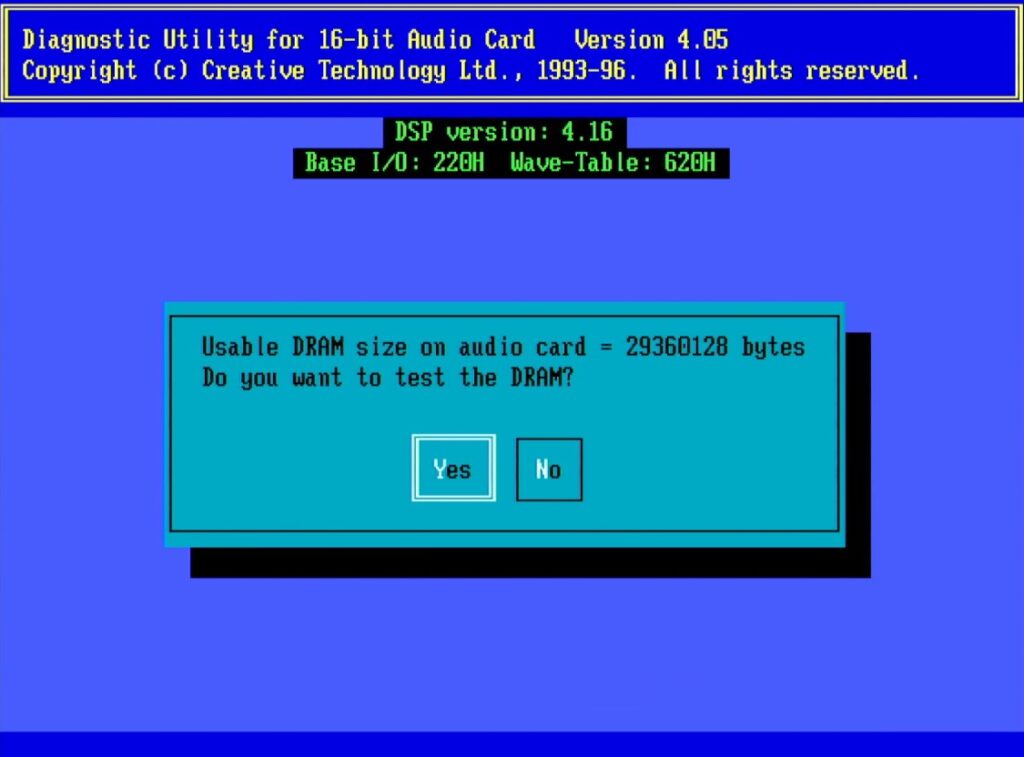
The road to the Rhapsody was no cakewalk. One hair-pulling moment came when the board stubbornly reported only 8MB! Luckily, I was able to confirm that only half the memory chips were active based on thermal images. I have to admit, debugging electronics isn’t easy. I dug into the PALASM code and found a sneaky conflict in the CAS equations – basically, the card was ignoring half its memory because of a logic hiccup. After tweaking the equations to relax the address conditions (a nerdy triumph!), we hit 28MB, and the best part? The same file worked on both Value and Gold, making the Rhapsody a true universal solution. No more different PCBs for your AWE64 Value or Gold, no jumpers, no configuration!
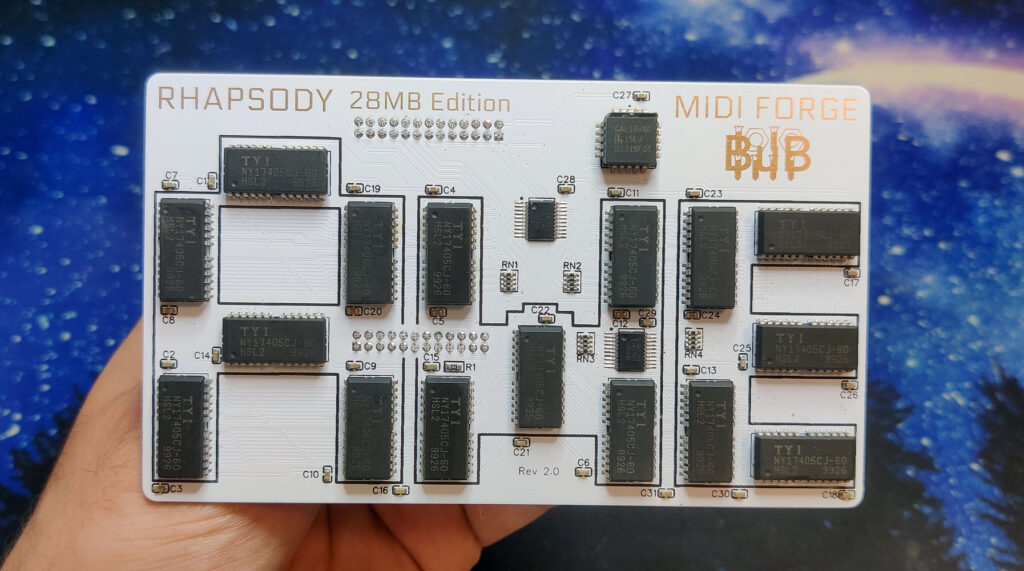
This project is all about keeping the AWE64’s legacy alive with a modern twist. The MIDI FORGE Rhapsody isn’t just a replica – it’s better, blending easier sourcing, a killer look, and plug-and-play simplicity. Whether you’re a MIDI composer, a retro gamer, or a collector, this board lets you push your AWE64 to its limits. Want to join the revival? Grab the Gerber files, build your own, or email me for an assembled board. Let’s keep those SoundBlaster vibes rocking!
Gerber Files and compiled GAL Equations
| PCB fabrication | GAL chip programming (1x GAL16V8D chips) |
Bill of Materials (BOM)
| Name | Designator | Footprint | Quantity | Pins |
|---|---|---|---|---|
| 2.0MM 2*13P | H1 | HDR-TH_26P-P2.00-V-M-R2-C13-S2.00-2 | 1 | 26 |
| 2.0MM 2*12P | H2 | HDR-TH_24P-P2.00-V-F-R2-C12-S2.00-1 | 1 | 24 |
| 100nF | C1, C2, C3, C4, C5, C6, C7, C8, C9, C10, C11, C12, C13, C14, C15, C16, C17, C18, C19, C20, C21, C22, C23, C24, C25, C26, C27, C28, C29, C30, C31 | C0603 | 31 | 2 |
| 33Ω | R1 | R0603 | 1 | 2 |
| SN74F244DBR | U1, U2 | SSOP-20_L7.2-W5.3-P0.65-LS7.8-BL | 2 | 20 |
| GAL16V8A-15 | U3 | PLCC-20_L9.0-W9.0-P1.27-LS9.9-T | 1 | 20 |
| MT4C4M4E8DJ – or – GM71C17403CJ6 – or – 4M x 4bit EDO, 2K | U1_R0C0, U1_R0C2, U1_R1C0, U1_R1C2, U2_R0C0, U2_R0C2, U2_R1C0, U2_R1C2, U3_R0C0, U3_R0C2, U3_R1C0, U3_R1C2, U4_R0C0, U4_R0C2, U4_R1C0, U4_R1C2 | SOJ26-24 | 16 | 24 |
| 33Ω | RN1, RN2, RN3, RN4 | RES-ARRAY-SMD_0603-8P-L3.2-W1.6-BL | 4 | 8 |
Schematics
28MB in Windows 98!
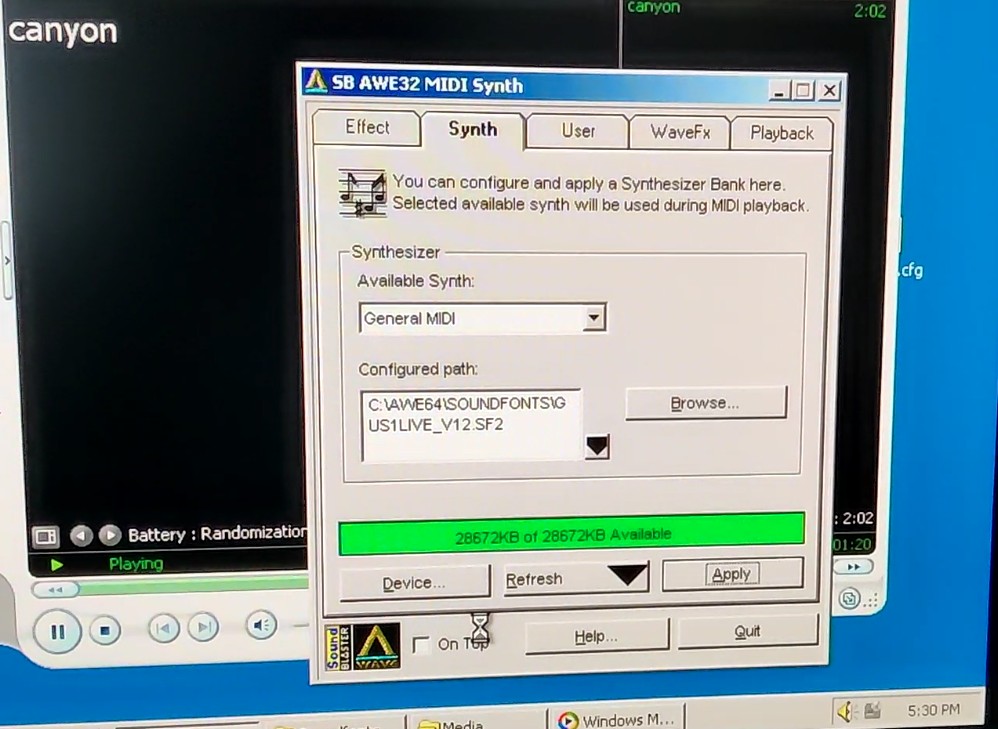
Digging Deeper
Since this is my own design and the GAL/PAL equations look nothing like the one from Creative or the one on the SIMMconn, I can share the code here as well. The GAL chip is responsible for decoding address lines. But before we dig deeper, let’s first understand what issues we are facing when using 4M x 4bit DRAM chips.
The AWE64 has a 16-bit data bus. That means, we need to have memory chips connected to the bus that saturate all 16 bits. If you recall from the Symphony board, we are using 1M x 16bit memory chips. That is great because one chip can saturate the entire data bus. If you want to hear more about this topic, I suggest to checkout the launch-video of the MIDI FORGE Rhapsody. In essence, the GAL chip monitor certain address lines and switch the active memory chip (Symphony) – or chip groups for the Rhapsody. Since the memory chips used on the Rhapsody boards only have 4 bits, we need 4 chips to saturate the entire data bus. Technically, we could build a very simple memory board by just using 4 memory chips – NO GAL chip required! But that is not why we’re here – we want to get the maximum 32MB (28MB usable).

The challenge of missing signals
Above is the design document I made myself in MS Paint. It shows how the control lines (CAS and RAS) are used to address the four groups of four chips each. Depending on their state, they can access each group individually. The problem? The AWE64 does not send the signals RAS0, RAS1, CAS0, and CAS2. (Don’t ask me about the naming convention of those signal lines – I just reused what I have seen on 72-pin SIMM modules).
The GAL chip and binary equations
Programmable Array Logic (PAL) chips – or Generic Array Logic (GAL) chips are programmable logic devices that can be programmed using PALASM (Programmable Array Logic Assembler). PALASM is an early hardware description language and there were many iterations and upgrades. However, I was successful using PALASM for the Sound Blaster 2.0 CM/S upgrade and stuck to it. First, it is easily accessible and didn’t send me through registration hell like WinCUPL or other tools.
The code you write in PALASM is then transcoded into a fuse map (e.g., JEDEC file) and loaded onto the chip using a device programmer.
I took inspiration of the SIMMconn adapter, however, I did not like the fact that you had apparently two different PCB designs for AWE64 Value and Gold cards – and different PAL/GAL equations. Btw, I was never successful to compile the equations of this project which seems to be encoded in ABEL format. Btw, the PCBs of the SIMMconn are identical for Value and Gold models – so, you should be able to use the same PCB for both Sound Blasters – you just need to replace the GAL chip with the right code for your card. But since my memory board will only ship with the full 28MB, it is much easier to code since I don’t have to take into account different memory sizes, refresh cycles, and so on. May I present to you – the secret GAL equations:
; Title: AWE64 Memory Interface GAL
; Author: Bits Und Bolts
; Date: April 2025
; Description: Configures 32MB DRAM (4 groups, 16 chips, 4M x 4, 2K-refresh) for AWE64 Value and Gold editions,
; achieving 28MB addressable memory. Compatible with PALASM 4 Market Release 1.5.
;---------------------------------- Declaration Segment -----------
TITLE AWE64_MEMORY_UPGRADE
PATTERN RHAPSODY
REVISION A
AUTHOR Bits Und Bolts
COMPANY Bits Und Bolts
DATE 28/04/25
CHIP AWE64Memory PALCE16V8
; Inputs
PIN 1 A11 ; Address bit for group selection (1: Groups 1 & 2, 0: Groups 3 & 4)
PIN 2 A10 ; Address bit for group selection (1: Groups 2 & 4, 0: Groups 1 & 3)
PIN 3 /RAS ; Row Address Strobe (active-low)
PIN 7 BASEM0 ; Base memory enable (see table below for details)
PIN 8 /CAS ; Column Address Strobe (active-low)
PIN 9 BASEM1 ; Base memory enable (see table below for details)
;
; BASEM1 and BASEM0 will determine the amount of DRAM available on the sound card
;
; BASEM1 BASEM0 On-Board Memory
; 0 0 8MB (unknown)
; 0 1 4MB (Gold)
; 1 0 2MB (Value)
; 1 1 0MB (Value)
; Outputs
PIN 12 /CAS2 ; CAS for Groups 1 & 3 (A11 = 0)
PIN 13 /CAS0 ; CAS for Groups 2 & 4 (A11 = 1)
PIN 14 /RAS0 ; RAS for Groups 1 & 2 (RA11 = 1)
PIN 15 CASD ; CAS driver signal
PIN 16 CBR ; CAS-before-RAS refresh (registered)
PIN 17 RA10 ; Latched A10 (registered)
PIN 18 RA11 ; Latched A11 (registered)
PIN 19 /RAS1 ; RAS for Groups 3 & 4 (RA11 = 0)
EQUATIONS
; Registered Outputs
RA11 = (/RAS * A11) + (RAS * RA11) ; Latch A11 when /RAS is active, hold otherwise
RA10 = (/RAS * A10) + (RAS * RA10) ; Latch A10 when /RAS is active, hold otherwise
CBR = (CASD * /RAS) + (/CASD * CBR) ; Detect CAS-before-RAS refresh cycles
; Combinatorial Outputs
CASD = /CAS ; Drive CAS signal
/CAS0 = /CAS + ( ( /(RA11 + A11 + RA10) * BASEM1 + A11 ) * /CBR ) ; Select Groups 2 & 4
/CAS2 = /CAS + ( ( /(RA11 + A11 + RA10) * BASEM1 + /A11 ) * /CBR ) ; Select Groups 1 & 3
/RAS0 = /RAS + ( RA11 * ( /CBR + /CAS ) ) ; Select Groups 1 & 2
/RAS1 = /RAS + ( /RA11 * ( /CBR + /CAS ) ) ; Select Groups 3 & 4DISCLAIMER: I am no expert when it comes to these equations and I have no idea what is happening there. It took me several iterations (maybe 10) of testing until I got it to work. Without AI, I would have to learn and study this topic. These equations are compatible with AWE64 Value and AWE64 Gold models.
I also would like to thank PCBWay for their awesome support helping me to build prototypes and refine the final board! Without their help, I wouldn’t have been able to get this project off the ground!

You can also order your PCBs directly from PCBWay. All parameters have already been set for you – just pick the color and finishing and you’ll have your PCBs in no time!
HELP! I can’t do this myself!
I got you covered! I will sell preassembled MIDI FORGE Rhapsody boards for 150 USD (includes shipping up to 25 USD). At the moment, I have matte black (with painted over Sound Blaster logo) and white with black silk screen PCBs.
All you need to do is to send me an email: bitsundbolts@gmail.com
The preferred methods of payment is Bitcoin/USDT (10 USD off if you pay in BTC) or via Patreon.
Unfortunately, PayPal blocked my account permanently for unknown reason.
If you sent an email may way, please include the following details:
Full Name:
Address:
Postal Code:
City:
Country:
Email:
Phone:
Preferred Color: White/Black
If you have any other questions, shoot them my way and I will try to answer them!
Cheers,
Alex
